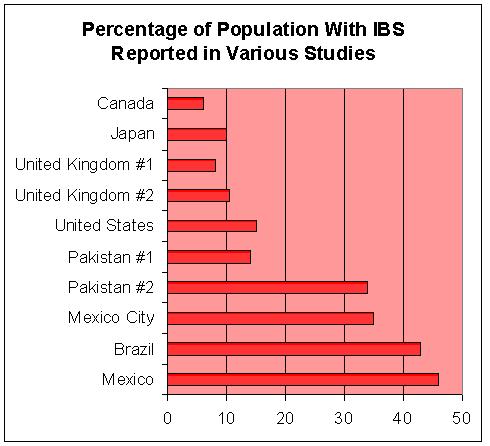Irritable bowel syndrome epidemiology and demographics
|
Irritable bowel syndrome Microchapters |
|
Differentiating Irritable bowel syndrome from other Diseases |
|---|
|
Diagnosis |
|
Treatment |
|
Case Studies |
|
Irritable bowel syndrome epidemiology and demographics On the Web |
|
American Roentgen Ray Society Images of Irritable bowel syndrome epidemiology and demographics |
|
FDA on Irritable bowel syndrome epidemiology and demographics |
|
CDC on Irritable bowel syndrome epidemiology and demographics |
|
Irritable bowel syndrome epidemiology and demographics in the news |
|
Blogs on Irritable bowel syndrome epidemiology and demographics |
|
Risk calculators and risk factors for Irritable bowel syndrome epidemiology and demographics |
Editor-In-Chief: C. Michael Gibson, M.S., M.D. [1]
Overview
Epidemiology and demographics

By Country: Studies have reported that the prevalence of IBS varies by country and by age range examined. The bar graph at right shows the percentage of the population reporting symptoms of IBS in studies from various geographic regions (see table below for references).
The following table contains a list of studies performed in different countries that measured the prevalence of IBS and IBS-like symptoms:
| Percentage of Population Reporting Symptoms of IBS in Various Studies from Various Geographic Areas | |||
|---|---|---|---|
| Country | Prevalence | Author/Year | Notes |
| Canada | 6%[1] | Boivin,2001 | |
| Japan | 10%[2] | Quigley,2006 | Study measured prevalence of GI abdominal pain/cramping |
| United Kingdom | 8.2%[3]
10.5%[4] |
Ehlin,2003
Wilson,2004 |
Prevalence increased substantially 1970-2004 |
| United States | 14.1%[5] | Hungin, 2005 | Most undiagnosed |
| United States | 15%[1] | Boivin,2001 | Estimate |
| Pakistan | 14%[6] | Jafri, 2007 | Much more common in 16-30 age range. Of IBS patients, 56% male, 44% female |
| Pakistan | 34%[7] | Jafri,2005 | College students |
| Mexico City | 35%[8] | Schmulson, 2006 | n=324. Also measured functional diarrhea and functional vomiting. High rates attributed to "stress of living in a populated city." |
| Brazil | 43%[2] | Quigley,2006 | Study measured prevalence of GI abdominal pain/cramping |
| Mexico | 46%[2] | Quigley,2006 | Study measured prevalence of GI abdominal pain/cramping |
Returning Travelers: A study of United States residents returning from international travel found a high rate of IBS and persistent diarrhea which developed during travel and persisted upon return. The study examined 83 subjects in Utah, most of whom were returning missionaries. Of the 68 who completed the gastrointestinal questionnaire, 27 reported persistent diarrhea that developed while traveling, and 10 reported persistent IBS that developed while traveling.[9]
References
- ↑ 1.0 1.1 Boivin M. (2001 Oct;15). "Socioeconomic impact of irritable bowel syndrome in". Canada. Can J Gastroenterol. Suppl B: :8B-11B. PMID 11694908. Check date values in:
|year=(help) - ↑ 2.0 2.1 2.2 Quigley EM, Locke GR, Mueller-Lissner S, Paulo LG, Tytgat GN, Helfrich I, Schaefer E. Prevalence and management of abdominal cramping and pain: a multinational survey. (2006 Jul). "Aliment Pharmacol Ther". 24 (2): 411–9. PMID 16842469. Check date values in:
|year=(help) - ↑ Ehlin AG, Montgomery SM, Ekbom A, Pounder RE, Wakefield AJ. (2003 Aug). "Prevalence of gastrointestinal diseases in two British national birth cohorts". Gut. 52 (8): 1117-21. PMID 12865268. Check date values in:
|year=(help) - ↑ Wilson S, Roberts L, Roalfe A, Bridge P, Singh S. (2004). "Prevalence of irritable bowel syndrome: a community survey". Br J Gen Pract. 54 (504): 495-502. PMID 15239910.
- ↑ Hungin AP, Chang L, Locke GR, Dennis EH, Barghout V (2005). "Irritable bowel syndrome in the United States: prevalence, symptom patterns and impact". Aliment. Pharmacol. Ther. 21 (11): 1365–75. doi:10.1111/j.1365-2036.2005.02463.x. PMID 15932367.
- ↑ Jafri W, Yakoob J, Jafri N Islam M, Ali QM. (2007 Jun). "Irritable bowel syndrome and health seeking behaviour in different communities of Pakistan". J Pak Med Assoc. 57 (6): 285–7. PMID 17629228. Check date values in:
|year=(help) - ↑ Jafri W, Yakoob J, Jafri N, Islam M, Ali QM. (2005 Oct-Dec). "Frequency of irritable bowel syndrome in college students". J Ayub Med Coll Abbottabad. 4 (17): 9–11. PMID 16599025. Check date values in:
|year=(help) - ↑ Schmulson M, Ortiz O, Santiago-Lomeli M, Gutierrez-Reyes G, Gutierrez-Ruiz MC, Robles-Diaz G, Morgan D. (2006). "Frequency of functional bowel disorders among healthy volunteers in Mexico City" (PDF). Dig Dis. 24: :342-7. PMID 16849861. Unknown parameter
|oissue=ignored (help) - ↑ Tuteja AK, Talley NJ, Gelman SS, Adler SC, Thompson C, Tolman K, Hale DC.
E. (2007). "Development of Functional Diarrhea, Constipation, Irritable Bowel Syndrome, and Dyspepsia During and After Traveling Outside the USA". Dig. Dis. Sci. PMID 17549631. line feed character in
|author=at position 74 (help)